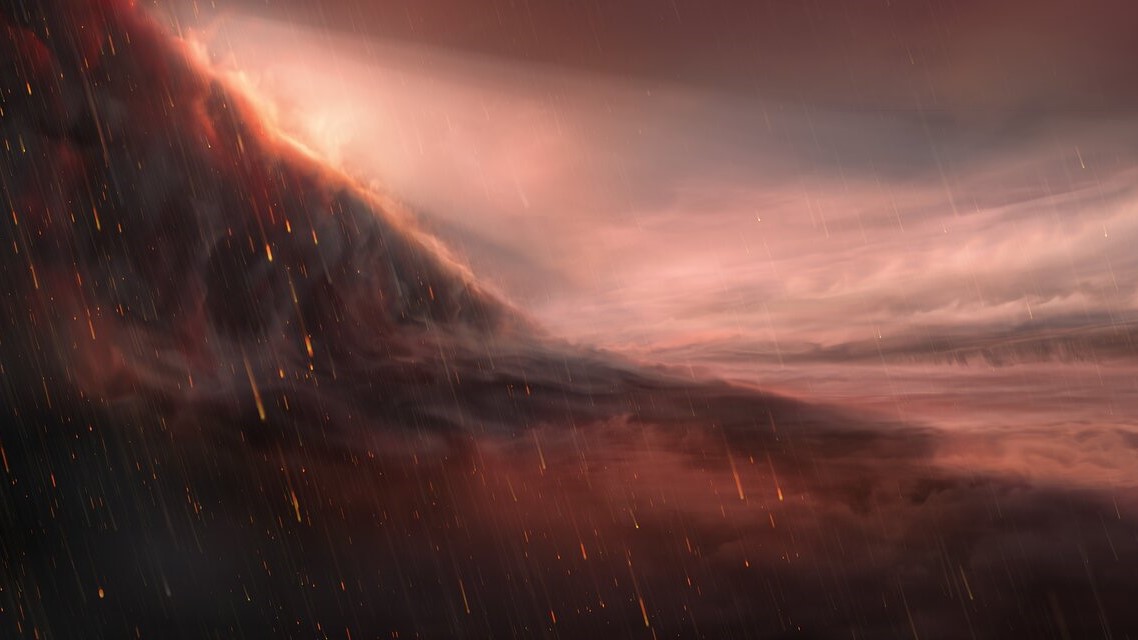Astronomers discover heaviest exoplanet element yet on alien world so hot it rains iron
Astronomers have detected barium around the ultra-hot gas giants WASP-76 b and WASP-121 b.
Astronomers have discovered the heavy element barium in the atmospheres of two blisteringly hot gas giant planets outside the solar system.
Detecting barium around the extreme exoplanets WASP-76 b and WASP-121 b marks the heaviest element ever found in the atmosphere of a planet orbiting a star other than the sun. The finding could reveal more about the exotic conditions found around exoplanets called hot Jupiters, which are gas giants that orbit close to their stars and are often tidally locked, with a hellish star-facing dayside and a relatively cool space-facing nightside.
Their proximity means that these Jupiter-size planets orbit their stars in just a few Earth days and can have temperatures in excess of 1,800 degrees Fahrenheit (1,000 degrees Celsius).
Related: 10 amazing exoplanet discoveries

WASP-76 b is a particularly extreme example of such a world — astronomers had previously discovered that its dayside temperature can soar as high as 4,350 F (2,400 C), hot enough to vaporize iron and other metals. When this vaporized iron is blown to the cooler nightside of WASP-76 b it liquefies and falls as "iron rain."
Even with these exotic and violent conditions, astronomers still weren't expecting to find barium, which is 2.5 times as heavy as iron, in the atmosphere of either WASP-76 b or WASP-121 b.
"The puzzling and counterintuitive part is: why is there such a heavy element in the upper layers of the atmosphere of these planets?" Tomás Azevedo Silva, research lead author and a Ph.D. student at the University of Porto and Instituto de Astrofísica e Ciências do Espaço, both in Portugal, said in a statement released by the European Southern Observatory, which operates some of the telescopes used in the research.
Get the Space.com Newsletter
Breaking space news, the latest updates on rocket launches, skywatching events and more!
The high gravity of the planets means that scientists would expect heavy elements like barium to quickly fall into the lower layers of the atmosphere, so the detection was surprising.
"This was in a way an 'accidental' discovery," Azevedo Silva said. "We were not expecting or looking for barium in particular and had to cross-check that this was actually coming from the planet since it had never been seen in any exoplanet before."
Azevedo Silva and his colleagues aren't sure what natural process could have left barium, which on Earth gives fireworks a bright green color, in the atmosphere of WASP-76 b or WASP-121 b.

Astronomers use a technique called spectroscopy to investigate the chemical composition of exoplanets. Spectroscopy is based on the fact that elements absorb and emit light at particular frequencies, so when starlight shines through the atmosphere of a world from its parent star, elements within the atmosphere give the light a specific "fingerprint."
Azevedo Silva and his team used the Echelle Spectrograph for Rocky Exoplanet and Stable Spectroscopic Observations (ESPRESSO) at the Very Large Telescope in Chile to determine the composition of the atmospheres of WASP-76 b and WASP-121 b.
Conveniently, hot Jupiters like these planets are particularly conducive to spectroscopy, which is made easier by proximity to a star, high temperatures and large atmospheres, so scientists still hope to figure out what is keeping barium aloft.
"At the moment, we are not sure what the mechanisms are," Olivier Demangeon, a co-author on the research and an astrophysicist at the University of Porto and Instituto de Astrofísica e Ciências do Espaço, said in the statement. "Being gaseous and hot, their atmospheres are very extended and are thus easier to observe and study than those of smaller or cooler planets."
In the future, astronomers will also be able to use instruments like the high-resolution Armazones High Dispersion Echelle Spectrograph (ANDES) on the Extremely Large Telescope currently being built in Chile. This instrument will be able to analyze the atmospheres of not only large planets like WASP-76 b and WASP-121 b, but also smaller worlds outside the solar system — including rocky exoplanets like Earth.
A paper describing the the team's work was published Thursday (Oct. 13) in the journal Astronomy & Astrophysics.
Follow us on Twitter @Spacedotcom and on Facebook.
Join our Space Forums to keep talking space on the latest missions, night sky and more! And if you have a news tip, correction or comment, let us know at: community@space.com.

Robert Lea is a science journalist in the U.K. whose articles have been published in Physics World, New Scientist, Astronomy Magazine, All About Space, Newsweek and ZME Science. He also writes about science communication for Elsevier and the European Journal of Physics. Rob holds a bachelor of science degree in physics and astronomy from the U.K.’s Open University. Follow him on Twitter @sciencef1rst.
